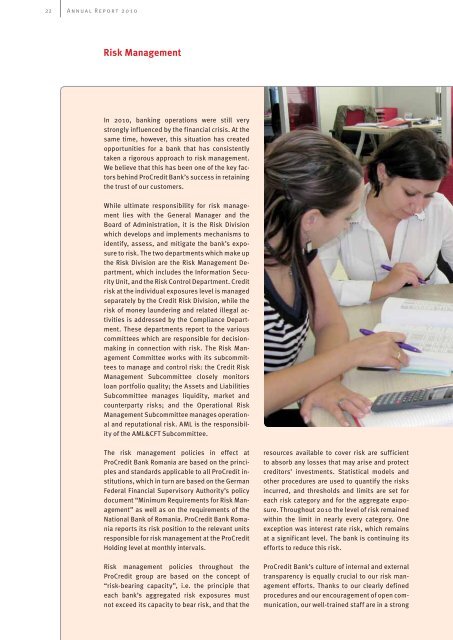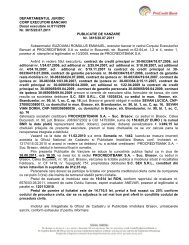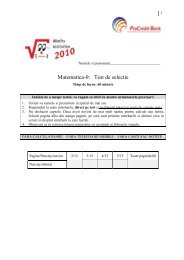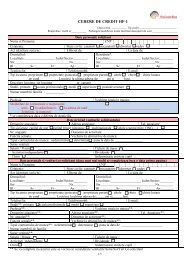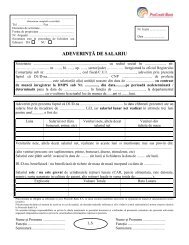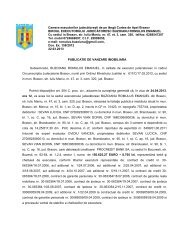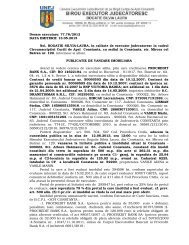Annual Report 2010 - ProCredit Bank
Annual Report 2010 - ProCredit Bank
Annual Report 2010 - ProCredit Bank
Create successful ePaper yourself
Turn your PDF publications into a flip-book with our unique Google optimized e-Paper software.
22<br />
<strong>Annual</strong> <strong>Report</strong> <strong>2010</strong><br />
Risk Management<br />
In <strong>2010</strong>, banking operations were still very<br />
strongly influenced by the financial crisis. At the<br />
same time, however, this situation has created<br />
opportunities for a bank that has consistently<br />
taken a rigorous approach to risk management.<br />
We believe that this has been one of the key factors<br />
behind <strong>ProCredit</strong> <strong>Bank</strong>’s success in retaining<br />
the trust of our customers.<br />
While ultimate responsibility for risk management<br />
lies with the General Manager and the<br />
Board of Administration, it is the Risk Division<br />
which develops and implements mechanisms to<br />
identify, assess, and mitigate the bank’s exposure<br />
to risk. The two departments which make up<br />
the Risk Division are the Risk Management Department,<br />
which includes the Information Security<br />
Unit, and the Risk Control Department. Credit<br />
risk at the individual exposures level is managed<br />
separately by the Credit Risk Division, while the<br />
risk of money laundering and related illegal activities<br />
is addressed by the Compliance Department.<br />
These departments report to the various<br />
committees which are responsible for decisionmaking<br />
in connection with risk. The Risk Management<br />
Committee works with its subcommittees<br />
to manage and control risk: the Credit Risk<br />
Management Subcommittee closely monitors<br />
loan portfolio quality; the Assets and Liabilities<br />
Subcommittee manages liquidity, market and<br />
counterparty risks; and the Operational Risk<br />
Management Subcommittee manages operational<br />
and reputational risk. AML is the responsibility<br />
of the AML&CFT Subcommittee.<br />
The risk management policies in effect at<br />
<strong>ProCredit</strong> <strong>Bank</strong> Romania are based on the principles<br />
and standards applicable to all <strong>ProCredit</strong> institutions,<br />
which in turn are based on the German<br />
Federal Financial Supervisory Authority’s policy<br />
document “Minimum Requirements for Risk Management”<br />
as well as on the requirements of the<br />
National <strong>Bank</strong> of Romania. <strong>ProCredit</strong> <strong>Bank</strong> Romania<br />
reports its risk position to the relevant units<br />
responsible for risk management at the <strong>ProCredit</strong><br />
Holding level at monthly intervals.<br />
Risk management policies throughout the<br />
<strong>ProCredit</strong> group are based on the concept of<br />
“risk-bearing capacity”, i.e. the principle that<br />
each bank’s aggregated risk exposures must<br />
not exceed its capacity to bear risk, and that the<br />
resources available to cover risk are sufficient<br />
to absorb any losses that may arise and protect<br />
creditors’ investments. Statistical models and<br />
other procedures are used to quantify the risks<br />
incurred, and thresholds and limits are set for<br />
each risk category and for the aggregate exposure.<br />
Throughout <strong>2010</strong> the level of risk remained<br />
within the limit in nearly every category. One<br />
exception was interest rate risk, which remains<br />
at a significant level. The bank is continuing its<br />
efforts to reduce this risk.<br />
<strong>ProCredit</strong> <strong>Bank</strong>’s culture of internal and external<br />
transparency is equally crucial to our risk management<br />
efforts. Thanks to our clearly defined<br />
procedures and our encouragement of open communication,<br />
our well-trained staff are in a strong


